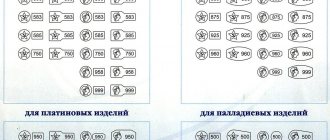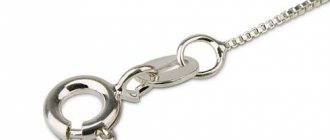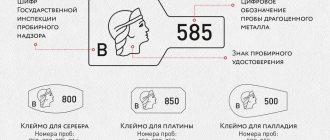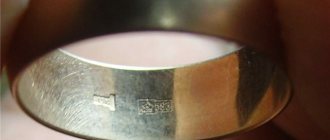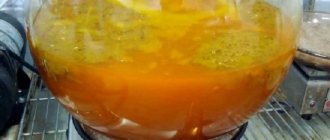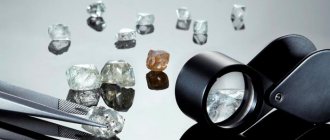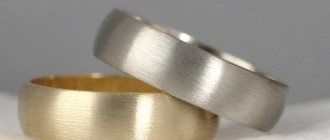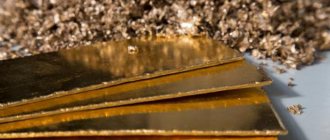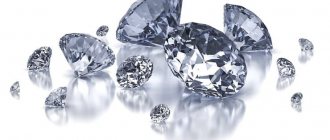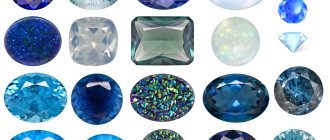Post updated: Oct 9, 2020
Very rarely gold is used in its pure form. Usually the product we call gold consists of the precious metal itself and the so-called alloy, that is, an admixture of other metals. Additives are included in the composition of gold to improve endurance and density, because gold in its pure form is very soft. Pure metal wears out quickly, and products made from it are very easy to scratch or break. High-quality products have a mark on the gold, which we will discuss later.
Even in ancient times, it was calculated that the best impurities for gold were silver and copper. Well, samples began to be used to indicate the gold content in the alloy.
Sample is the main indicator of impurities in a product, but stamps also serve this purpose - marks that are placed in control institutions and guarantee the presence of precious metal in the alloy.
In France, the first hallmark was placed in 1275, but in Russia, the first hallmark appeared on a product in Moscow in 1651-1652. It looked like a double-headed eagle with a date written in Slavic letters, and its purpose was to demonstrate the silver standard. Assays in the modern sense were introduced by Peter the Great in his decree of February 13, 1700, which established 4 assays each for gold and silver.
Gold hallmark systems
In the world there are metric, carat and spool systems for gold hallmarks. The most popular are carat and metric, of which the second is most often used. According to the British carat system, which is used in the USA, Switzerland and a number of other countries, a carat is equal to 1/24 of the mass of the entire alloy. Thus, 24 carat gold is a pure substance without additives, but 18 carat means 18 parts of gold in the total proportion of the mixture of metals. In the jewelry industry, you can most often find samples: 9, 10, 14, 18 and 24.
In Russia, since 1711, a spool sampling system has been in use for silver alloys, and in 1733 it was introduced for gold. This measure was invented on the basis of the Russian pound, which contains 96 spools, and the standard itself was expressed by the weight of gold in 96 alloy units. Pure gold had a 96 hallmark, and at the end of the 19th - early 20th centuries, the 56th, 72nd, 82nd, 92nd and 94th hallmarks were in use.
In 1927, the USSR switched to the metric calculation system; all manufactured products that previously had a spool marking changed it to metric. The new system was identical to the German one, and the sample number ranged from 0 to 1000 and demonstrated the presence of gold in the alloy.
Today, many countries use metric quality standards (the most accurate system). In them, the highest standard is the 1000th, but in fact it is not found, and the mark on gold can be a number up to 999.9.
In connection with the problem of calculation errors in the glory of gold, a so-called remedium is established, in other words, a deviation from the norm. In compounds of silver and gold, gold and copper, and all three components together, the remedium is usually set to 3 units. For example, a 583-carat alloy should have a remedium of 3 units, therefore, the gold content will be approximately 580-586 g/1 kg of alloy. Gold alloys with an admixture of nickel have a remedium of 5 units.
In Russia, jewelry for sale can have hallmarks from 375 to 958. The Union also had gold of the 583rd standard, but in Europe there was a standard of 14 carats, which had indicators higher than the Soviet one. To avoid a lower price for our gold in Europe, the standard was changed to 585.
In the modern Russian system, 23-karat gold corresponds to the 958th hallmark, 18-karat gold to the 750th, and so on. To convert from metric to carat, you need to multiply the sample by 0.024.
Decoding of the name
1 - year code 2 - code of the State Inspectorate of Assay Supervision, in the area of operation of which the manufacturer is located 3 - manufacturer code
breakdown by year: A - 2001, B - 2002, C - 2003, D - 2004, D - 2005, E - 2006, C - 2007, I - 2008
- the second indicates the inspection of the assay office: L - North-Western (no change)
| Assay inspections | Location | Codes on stamps |
| 1. Verkhne-Volzhskaya | r/p Krasnoe-on-Volge, Kostroma region. | IN |
| 2. Volgo-Vyatka | Nizhny Novgorod | G |
| 3. East Siberian | Krasnoyarsk | I |
| 4. Far Eastern | Khabarovsk | YU |
| 5. Donskaya | Rostov-on-Don | TO |
| 6. Western | village Yantarny, Kalaningrad region. | F |
| 7. Transbaikal | Ulan-Ude | AND |
| 8. West Siberian | Novosibirsk city | N |
| 9. Povolzhskaya | Ufa | P |
| 10. Podmoskovnaya | Bronnitsy, Moscow region. | B |
| 11. Prikaspiyskaya | Makhachkala | Z |
| 12. Sakha | Yakutsk | D |
| 13. North | Veliky Ustyug, Vologda region. | A |
| 14. North-West | Saint Petersburg | L |
| 15. Ural | Yekaterinburg city | WITH |
| 16. Central | Moscow | M |
— the last characters identify the manufacturer (without change)
As you can see, by the name and assay mark you can really find out what any product intended for sale in Russia is.
Popular gold samples
In our country there are five levels of quality of gold products.
375th sample is an alloy containing 38 percent metal (impurities - silver and copper), having a color range from yellow to reddish; over time, this mixture fades.
500th - an alloy with 50.5 percent gold (impurities - silver and copper).
585th is a mixture of 58.5 percent gold with silver, copper, palladium and nickel. This combination makes the product hard, durable, and resistant to air, which is why it is often used in production.
750 is an alloy with a 75.5 percent precious metal content mixed with silver, platinum, copper, nickel and palladium. It can range in color from green and yellow to pink and reddish. Quite durable, but well processed and polished. Very popular for making jewelry, used for high-precision work.
958 is an alloy with a gold content of 95.38 percent, which is rarely used due to its softness and inexpressive color.
Alloys higher than 750 standard are not susceptible to tarnishing when interacting with air, and 999 standard is not used due to poor reliability indicators. For works of art, the 958th standard is best suited, the 900th is used for minting, and for jewelry purposes the 585th standard is used.
Hallmark 583 in the modern world: how jewelers and pawnshops evaluate it
After several decades, 583, the old standard of gold, fell from the first place in the popularity of precious metals. Today, disputes arise less and less frequently compared to 585 and 583 samples. However, the price of 585 samples is several hundred rubles per gram higher than the cost of its competitor.
Foreign jewelers speak negatively about 583 samples. However, their negative attitude is not true. 583 standard gold in the USSR, with proper maintenance, does not lose its beauty, because it has:
- radiance that does not disappear for years;
- bulkiness and reliability, which avoids damage;
- corrosion resistance.
585 gold wedding ring
Hallmarks on gold
In all countries, the metal content in alloys is controlled by government agencies, and if jewelry is produced by a jewelry corporation, then verification is carried out internally. For example, in Holland the production of silver and gold products of any quality is completely permitted.
In the Russian Federation, the share of gold in the alloy is determined by the state and is indicated in the decree “On the procedure for testing and marking products made of precious metals.” Products made from such metals must have a state mark and comply with Russian standards.
The testing and hallmarking procedure is carried out by the Russian State Assay Office, located under the Ministry of Finance. And compliance with gold hallmarks and their compliance with reality is monitored by specialists from the Federal Assay Supervision.
In Turkey, Egypt, Greece and the USA, gold and silver products are not controlled. In this regard, Russian jewelers say that 90% of Turkish gold does not correspond to the declared quality: often, with the specified 585th standard, it actually barely reached 500th. But recently, trust in Turkish hallmarks has completely disappeared, the fact is that in any store in this country you can choose an unmarked gold product, after which the seller will put the desired digital marking on it using a special machine.
Usually, the image of the mark combines a certain design and digital marking of the sample, and the sample itself, as mentioned earlier, is placed by government services.
What is a name tag
Let's look at what a name tag is. Sometimes on jewelry you can find a master's mark, which is also called a name mark, but it does not prove quality.
The name tag refers more to the personal signature of some jeweler and the company that produced the item from the precious metal. If decrypted, it should contain additional information about it.
For an inexperienced buyer, the information included in the name plate will mean little. Only specialists or other jewelers will be able to tell with one glance at the personalized seal who made the jewelry, where and in what year. Since 1986, all jewelry manufacturers have been required to label them themselves.
After a year, the old name book must be destroyed. Its re-registration is carried out annually and differs from the previous one in the code of the year of manufacture. Many workshops can, at the customer’s request, put any inscription on gold jewelry. This could be either a word that is important to him or a date of birth or wedding. This is especially true for people who are planning to get married.
Types of stamps
Different designs and shapes are used to mark products in different countries, so what marks are depicted on gold in different countries? For example, in Belarus, a bison is placed on products. Until 1896, in Russia, “tees” were placed - stamps on which the hallmark number, coat of arms, the first letters of the name of the inspector and the year the stamp was placed were combined into one pattern. And if before 1897 the signs themselves had a convex shape, then after this year they acquired a depressed appearance.
Already in 1899, one brand was introduced in Russia - the “sign of identification”, which looked like a female head in a kokoshnik, depicted in profile on the left.
From 1908 to 1927, other brands worked with the same head in a kokoshnik, but turned in the other direction, moreover, accompanied by a Greek letter, varying depending on the region of Russia.
In 1927, a new brand appeared in Russia - the head of a worker with a hammer, and the calculation itself was converted to metric. Since July 1, 1958, for products made from all precious metals, a mark in the form of a five-pointed star, inside of which there was a sickle and a hammer, began to be used.
Now Russian jewelry is also branded with a woman’s head in a kokoshnik. The mark can be either combined or placed separately. On the stamp of the combined type in the frame there is a head in a kokoshnik looking to the right and numbers indicating the hallmark, and to the left of the head there is a small letter indicating the State Inspectorate, which put the hallmark.
To stamp separate or easily separated items, a separate type stamp is used, the head is placed on one, and the hallmark numbers are placed on the other part of the product.
Jewelry made in Russia must have the imprint of the State Inspectorate and the manufacturer's mark with an encrypted year of branding and the encrypted name of the enterprise.
Jewelry factory name
Jewelry must also bear the manufacturer’s marking – name plate (jewelry). He is:
- a sign identifying the jeweler (enterprise or individual entrepreneur);
- designation of the year of manufacture.
Jewelry names are updated (every new year), approved and registered by the Assay Office. The symbols of the plant's name are applied only side by side - placed in one outline. Both markings are usually visible if it is
- ring - inside;
- pendant – outside;
- earring, chain - with a lock.
The year of issue (marking) on the nameplate since 2001 is indicated by the first letter. For example, 2005 is the fifth letter of the alphabet “D”. The second letter indicates the location of the jewelry production. And the following characters are the manufacturer’s code. Following the recommendations of the Assay Office, jewelers use one or two Russian letters.
Fake gold standard
Not every swindler will decide to counterfeit a gold sample, since it is difficult and involves huge risks. Typically, fraud involves putting a high standard on a low-quality product that still contains gold. Similar products can be bought in small shops around the world, but by chance they can also be sold in decent jewelry stores. A well-made counterfeit sample is almost impossible to detect by eye, which is why it is necessary to check the alloy itself.
A portable device that can help with this is a gold detector that you can carry with you while shopping. It is worth remembering that the device may have its limitations and errors, so you should not trust it completely.
Reviews
My great-grandmother and great-grandfather passed on their former wedding rings to my sister and me. I was lucky - I got something bigger! So, when I was getting ready to get married, my groom and I decided to make their rings based on the chosen picture from the Internet. We collected all the unnecessary gold at home, including old rings. And the master made two of our rings from one great-grandfather’s ring; he didn’t need the rest of the products!
Maria P. g, Moscow
Alisa T. g, Ivanovo
I decided to say goodbye to the old gold I didn’t need (I had one earring lying around, a missing crown), and took it to the pawnshop. The buyer said that such metal is valued cheaper than modern metal. I'll try to go to another salon.
I lost my old gold chain, which I managed to buy back in Soviet times. I still can’t find something suitable for myself. Modern products seem too thin and fragile. And the thick chains still cost as much as a car.
Valentina P., Donetsk
Recommendations for care and cleaning
Since the products contain a high proportion of silver - a soft and elastic metal - their care requires compliance with the following rules:
- Strong mechanical impact is not allowed: the surface should be wiped with suede or a soft cloth;
- Jewelry should be removed when doing housework and preparing food;
- To clean products, use a vinegar solution (2 spoons per 1 liter of water).
Any item made from this alloy must be used carefully and carefully, avoiding impacts or falling.
Legal sale of precious metals
The sale of 9999 gold bars, the table and prices for which are shown below, is carried out by many Russian banks. The cost per gram increases during periods of economic instability and decreases during periods of calm - this is a market pattern. As of March 12, 2021, it is 82.9% of the level of 3 years ago on the same date. However, over the last year the growth was 22.19% (Fig. 3, Table 3). Purchasing bullion and opening an impersonal metal account (UMA) are popular investment methods.
Table 3. Selling price of gold bullion by Russian banks on March 10-12, 2021
| Bank's name | price for 1g in rub. | net weight (mass) | total cost of the ingot, rub. |
| AK Bars Bank | 3 862,00 | 1 | 3 862 000,00 |
| Sberbank of Russia | 3 859,00 | 1 | 3 859 000,00 |
| Gazprombank | 4 576,62 | 1 | 4 576 620,00 |
| Lanta-Bank | 3 899,58 | 1 | 3 899 580,00 |
| Bank of Moscow | 3 919,16 | 1 | 3 919 160,00 |
| Promsvyazbank | 3 974,35 | 1 | 3 974 350,00 |
| MTS bank | 3 379,31 | 1 | 3 379 310,00 |
| Uralprombank | 3 866,91 | 5 | 19 334 550,00 |
| KB Bank for Technology Development | 3 300,00 | 5 | 16 500 000,00 |
| National Collateral Bank | 5 090,80 | 5 | 25 454 000,00 |
| MDM Bank | 3 687,36 | 20 | 73 747 200,00 |
Almost a third of the world's gold reserves are the reserves of the IMF and State Central Banks of different countries. The rest is in the hands of the population, mainly in the form of jewelry. Until now, the volume of gold serves as an indicator of the welfare of the state, despite the fact that current currencies are not directly linked to a particular amount of this metal.
Coin catalog
All existing coins can be found in our database using a convenient search.
Very rarely gold is used in its pure form. Usually the product we call gold consists of the precious metal itself and the so-called alloy, that is, an admixture of other metals. Additives are included in the composition of gold to improve endurance and density, because gold in its pure form is very soft. Pure metal wears out quickly, and products made from it are very easy to scratch or break. High-quality products have a mark on the gold, which we will discuss later.
Even in ancient times, it was calculated that the best impurities for gold were silver and copper. Well, samples began to be used to indicate the gold content in the alloy.
Sample is the main indicator of impurities in a product, but stamps also serve this purpose - marks that are placed in control institutions and guarantee the presence of precious metal in the alloy. In France, the first mark was placed in 1275, but in Russia the first mark appeared on a product in Moscow in 1651-1652. It looked like a double-headed eagle with a date written in Slavic letters, and its purpose was to demonstrate the silver standard. Assays in the modern sense were introduced by Peter the Great in his decree of February 13, 1700, which established 4 assays each for gold and silver.
Application area
875 silver, especially with a star mark, is a practical and reliable precious alloy. The scope of its use is wide: from tableware to luxury jewelry.
Decorations
Our most popular jewelry made from silver marked with a star is:
- pendants and pendants;
- brooches;
- rings;
- cufflinks;
- earrings.
Bracelets and chains were less commonly made.
Many Soviet products contain precious stones, glass inclusions, and crystals.
Dishes
Tableware is the main area of application for 875 alloys:
- spoons, forks, knives,
- cup holders,
- trays,
- candlesticks and vases,
- bowls and glasses, etc.
Industry
Slaves with a silver content of 0.875 are used in industry:
- production of contacts and relays,
- as an integral component of rechargeable batteries,
- element of capacitors, microwave ovens, etc.
Composition and properties
Silver products are made from alloys to which other metals are added - alloys. Their task is to give the material additional characteristics that increase its practicality, strength or visual component.
Silver with purity 875 has a certain composition, set out in the international standard:
Silver metal content in 1 gram of 875 grade product
| Main component | Grams | Carats |
| Silver | 0,875 | 21 |
The carat system has become widespread along with the metric system for assessing the degree of purity of alloys in the Arab world, the USA, etc. Carats refers to the amount of the main substance in the metal, the maximum value is 24 (equal to 100% concentration).
The main additive of 875 silver alloy is copper. In addition to it, nickel, silicon, germanium or platinum are alloys.
Copper is a cheap metal that, in addition to reducing the cost of the finished alloy, increases its strength and durability. The disadvantage of alloying with copper is the change in appearance over the years: the surface becomes dull and the shine disappears. To eliminate this phenomenon, many products made from 875 standard are coated with rhodium: it gives additional shine and metallic luster and protects against mechanical stress.
Main characteristics of metal with the mark 875:
- hardness;
- plastic;
- impact resistance;
- low melting point values;
- high light reflection rate (almost 100%);
- light yellow tint.
Strength
The strength and stability of 875 silver depends on the final volume of copper impurities. The alloy is distinguished by higher strength and ductility than silver of the highest standard: the metal in its natural state is soft, the higher the proportion of pure Ag, the lower the strength of the product.
